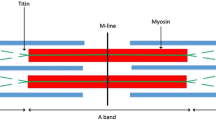Summary
Synaptic currents were measured in voltage clamped crayfish muscle fibers which were triggered either by stimulation of the motor axon (EPSC), or byl-gutamate (gEPSC) applied by microiontophoresis or superfusion. Among a number of analogues of glutamate,l-glutamic-acid-γ-methyl ester,l-glutamic-acid-dimethyl ester andl-aspartate, were reasonably specific antagonists at the motor synapses, although at relatively high concentrations. Also, 2-amino-4-phosphono-butyric acid and morphine were effective antagonists; the action of morphine, however, seemed to be unspecific.
Aspartate was further shown to decrease the size of the quantum EPSC, without affecting the probability of release of transmitter or the potential change recorded from the presynaptic nerve terminal. The results also indicate that aspartate, after longer incubations, is released as a false transmitter. The dose-response curve to short glutamate pulses is shifted by aspartate to higher glutamate concentrations, without affecting the steep slope of the dose-response curve or the saturation level. This effect can be interpreted as competitive inhibition by aspartate, with an equilibrium concentration of aspartate at the receptor of 0.3–1.5 mmol/l. In longer glutamate applications the receptor desensitizes rapidly. Aspartate reduces this desensitization in addition to its competitive inhibitory effect. Suppression of desensitization can be more effective than inhibition in long glutamate applications; in this case aspartate apparently potentiates the effects of glutamate.
Similar content being viewed by others
References
Clements, A. N., May, T. E.: Pharmacological studies on a locust neuromuscular preparation. J. exp. Biol.61, 421 (1974)
Curtis, D. R., Johnston, G. A. R.: Amino acid transmitters in the mammalian central nervous system. Ergebn. Physiol.69, 97 (1974)
Dudel, J.: The action of inhibitory drugs on nerve terminals in crayfish muscle. Pflügers Arch. ges. Physiol.284, 81 (1965)
Dudel, J.: Nonlinear voltage dependence of excitatory synaptic current in crayfish muscle. Pflügers Arch.352, 227 (1974)
Dudel, J.: Potentiation and desensitization after glutamate induced postsynaptic currents at the crayfish neuromuscular junction. Pflügers Arch.356, 317 (1975a)
Dudel, J.: Kinetics of postsynaptic action of glutamate pulses applied iontophoretically through high resistance micropipettes. Pflügers Arch.356, 329 (1975b)
Dudel, J.: Aspartate: A competitive inhibitor of glutamate synaptic action and of EPSCs in crayfish. Pflügers Arch.359, R 85 (1975c)
Dudel, J.: Dose-response curve of glutamate applied by superfusion to crayfish muscle synapses. Pflügers Arch.368, 49 (1977)
Johnson, E. W., Wernig, A.: The binomial nature of transmitter release at the crayfish neuromuscular junction. J. Physiol. (Lond.)218, 757 (1971)
Katz, B., Thesleff, S.: A study of the desensitization produced by acetylcholine at the motor end-plate. J. Physiol. (Lond.)138, 63 (1957)
Kerkut, G. A., Wheal, H. V.: The excitatory effects of aspartate and glutamate on the crustacean neuromuscular junction. Brit. J. Pharmacol.51, 136 (1974)
Kosterlitz, H. W., Lees, G. M., Watt, A. J.: Non-specific effects of morphine-like drugs. Pharmacol. Res. Commun.1, 42 (1969)
Kravitz, E. A., Slater, C. R., Takahashi, K., Bownds, M. D., Grossfeld, R. M.: Excitatory transmission in invertebrates-glutamate as a potential neuromuscular transmitter compound. In: Excitatory synaptic mechanisms (P. Andersen and J. K. S. Jansen, eds.), pp. 85–93. Oslo: Universtetsvorlaget, 1970
Lowagie, C., Gerschenfeld, H. M.: Glutamate antagonists at a crayfish neuromuscular junction. Nature (Lond.)248, 533 (1974)
Nistri, A., Constanti, A.: Effects of glutamate and glutamic acid diethyl ester on the lobster muscle fibre and the frog spinal cord. Europ. J. Pharmacol.31, 377 (1975)
Onodera, K., Takeuchi, A.: Permeability changes produced byl-glutamate at the excitatory post-synaptic membrane of the crayfish muscle. J. Physiol. (Lond.)255, 669 (1976)
Pert, C. B., Aposhian, D., Snyder, S. H.: Phylogenetic distribution of opiate receptor binding. Brain Res.75, 356 (1974)
Shank, R. P., Freeman, A. R.: Cooperative interaction of glutamate and aspartate with receptors in the neuromuscular excitatory membrane in walking limbs of the lobster. J. Neurobiol.6, 289 (1975)
Shank, R. P., Freeman, A. R.: Agonistic and antagonistic activity of glutamate analogs on neuromuscular excitation in the walking limbs of lobsters. J. Neurobiol.7, 23 (1976)
Shank, R. P., Freeman, A. R., McBride, W. J., Aprison, M. H.: Glutamate and aspartate as mediators of neuromuscular excitation in the lobster. Comp. Biochem. Physiol.50C, 127 (1975)
Takeuchi, A., Takeuchi, N.: The effect on crayfish muscle of iontophoretically applied glutamate. J. Physiol. (Lond.)170, 296 (1964)
Takeuchi, A., Takeuchi, N.: Actions of transmitter substances on the neuromuscular junctions of vertebrates and invertebrates. Advanc. Biophys.3, 45 (1972)
Thoenen, H.: Bildung und funktionelle Bedeutung adrenerger Ersatztransmitter. Berlin-Heidelberg-New York: Springer 1969
Usherwood, P. N. R., Cull-Candy, S. G.: Pharmacology of somatic nerve-muscle synapses. In: Insect muscle (P. N. R. Usherwood, ed.). London: Academic Press 1975
Werman, R.: An electrophysiological approach to drug-receptor mechanisms. Comp. Biochem. Physiol.30, 997 (1969)
Wheal, H. V., Kerkut, G. A.: The effect of diethyl esterl-glutamate on evoked excitatory junction potentials at the crustacean neuromuscular junction. Brain Res.82, 338 (1974)
Wheal, H. V., Kerkut, G. A.: Structure activity studies on the excitatory receptor of the crustacean neuromuscular junction. Comp. Biochem. Physiol.53C, 51 (1976)
Zieglgänsberger, W., Bayerl, H.: The mechanism of inhibition of neuronal activity by opiates in the spinal cord of cat. Brain Res.115, 111 (1976)
Zucker, R. S.: Changes in the statistic of transmitter release during facilitation. J. Physiol. (Lond.)229, 787 (1973)
Author information
Authors and Affiliations
Additional information
This work was supported by the Deutsche Forschungsgemeinschaft
Rights and permissions
About this article
Cite this article
Dudel, J. Aspartate and other inhibitors of excitatory synaptic transmission in crayfish muscle. Pflugers Arch. 369, 7–16 (1977). https://doi.org/10.1007/BF00580803
Received:
Issue Date:
DOI: https://doi.org/10.1007/BF00580803




